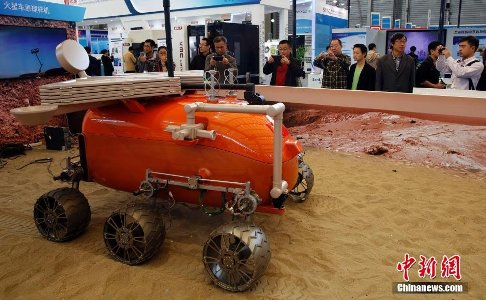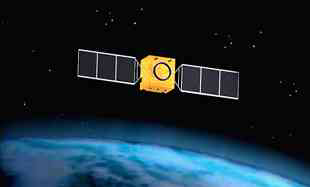
A prototype of China's Mars rover at the 16th China International Industry Fair in Shanghai. Photo: China News Service/ Tang Yanjun
BEIJING (PTI): Seeking to catch up with India's Mangalyaan mission, China has unveiled its Mars rover being developed to scurry the Red Planet's surface for signs of water and life and plans to test it in the rugged terrain of Tibet.
China Aerospace Science and Technology Corporation (CASC) has displayed the machine and the technological hardware set-up at an air show.
Photos of the rover's prototype, to be displayed at the annual air show at Zhuai being attended by Defence Attaches of all countries including India, were carried by the State-run Xinhua news agency.
The robotic rover was to crawl over the rough Martian terrain with a powerful six-wheel drive.
At a glace it looks similar to Yutu or Jade Rabbit that China has sent to Moon to explore the lunar surface.
But the Chinese scientists carried out some significant design changes to deal with different environment on Mars, the Hong Kong based South China Morning Post reported.
To beef up communication at longer distance, the rover carries on its back a large dish antenna, which was smaller and mounted at the neck on Yutu.
The wheels were also more solidly constructed than those on Yutu in order to deal with a rockier landscape.
The entire Mars exploration system will include an orbiter, lander and the rover, CASC said.
Some intriguing issues regarding the rover, such as whether it would carry a nuclear power source and the types of scientific payload on board, have still not been answered, the Post said.
Yutu was crippled soon after landing on the moon, probably
due to low temperatures and fine dust.
The average temperature on Mars is lower than that of the Moon due to its distance from the sun, and the notorious dust storms would also be imposing enormous challenge to the rover.
Ouyang Ziyuan, Chief Scientist of China's lunar project, told state media earlier this year that China's second mission to Mars would be launched as early as 2020, and that by 2030 an unmanned spacecraft would return from the planet with samples.
While Mangalyaan caught China by surprise, it fascinated them as it was sent with a modest budget of less than USD 100 million.
With successful space missions to Moon as well as efforts to build a space station of its own, China also made a failed bid in 2011 to send its probe to Mars.
The satellite Yinghuo-1 was launched by a Russian rocket but failed to reach the orbit and was declared lost.
The scientific community has high hopes from the Mars project as the planet, with its carbon-rich atmosphere and signs of water, was the most feasible one for eventual human settlement besides the Earth, the Post said.
It added report that scientists were preparing for the project by looking for somewhat similar terrain on the Tibetan plateau to build a prototype of a Martian base with cutting-edge life-supporting equipment and technology.
They also proposed growing worms with rich protein as a source of food supply for the first residents on the planet, the report said.
The ambitious project, however, faces various hurdles as the government has not set an official time line due to political and technical concerns.
China still lags behind Russia in some critical areas regarding space technology, such as large rockets and deep space communication, the Post report said.
The Mars project, believed to be more costly than China's lunar missions, would also need to compete for money and sources with other equally ambitious projects being considered by the government.
The country is reviewing proposals for landing a human on the moon and sending spacecrafts on three asteroids most likely to hit the earth, all scheduled to start around 2020.
 Previous Article
Previous Article Next Article
Next Article













The Indian Air Force, in its flight trials evaluation report submitted before the Defence Ministry l..
view articleAn insight into the Medium Multi-Role Combat Aircraft competition...
view articleSky enthusiasts can now spot the International Space Station (ISS) commanded by Indian-American astr..
view article